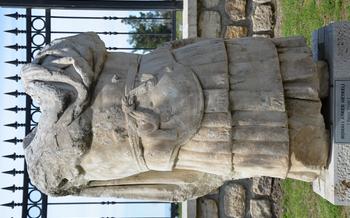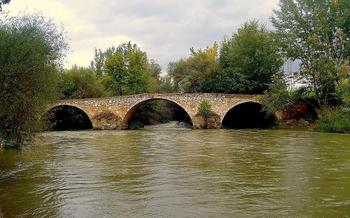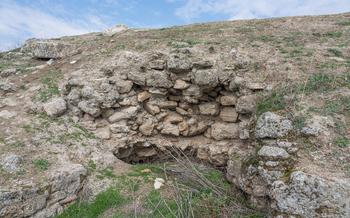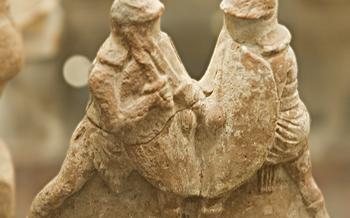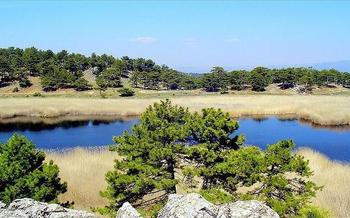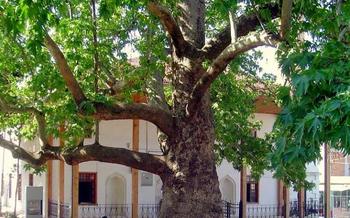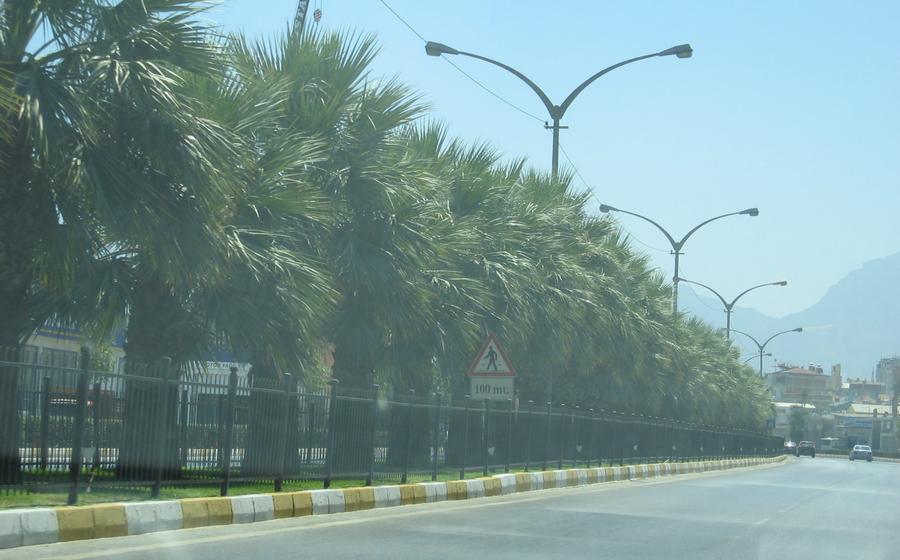
Çatalçeşme Theatre Hall
- The Antiquity of Çatalçeşme Theatre Hall
- Location and Accessibility:
- Architectural Highlights
- Historical Significance
- Current Usage and Events
- Explore Nearby Ruins
- Best Time to Visit
- Photography and Videography
- Bring Water and Sunscreen:
- Respect the Historical Site
- Plan Your Visit with a Guide
- Learn About Ancient Theatre Performances
- Imagine Being an Ancient Audience Member
- Insider Tip: Discover the Hidden Gem of the Çatalçeşme Theatre Hall
The Antiquity of Çatalçeşme Theatre Hall
The Çatalçeşme Theatre Hall stands as a proud testament to the rich history of Denizli, Turkey. Nestled within the ancient city of Hierapolis, this theatre has witnessed centuries of captivating performances and played an integral role in the cultural and artistic life of the region.
Hierapolis, founded by the Seleucid king Eumenes II in the 2nd century BC, flourished as a prominent center of trade, religion, and culture. The construction of the theatre, estimated to have taken place during the Roman era in the 1st century AD, reflects the city's opulence and dedication to the arts.
Built in the typical style of Greco-Roman theatres, the Çatalçeşme Theatre Hall boasts remarkable architectural features. Its horseshoe-shaped auditorium, capable of accommodating up to 12,000 spectators, offers breathtaking views of the stage and the surrounding landscape. The stage, adorned with intricate carvings and friezes, served as the platform for diverse performances, including plays, concerts, and religious ceremonies.
The discovery and restoration of the Çatalçeşme Theatre Hall have been marked by fascinating anecdotes. In the late 19th century, the ruins of the theatre were rediscovered by European explorers who were captivated by its grandeur. Subsequent excavations and restoration efforts, meticulously undertaken by archaeologists and historians, have brought this ancient marvel back to life, allowing us to appreciate its splendor and immerse ourselves in its captivating history.
Location and Accessibility:
The Çatalçeşme Theatre Hall is situated in the ancient city of Hierapolis, which lies within the boundaries of the modern city of Denizli, Turkey. To reach this historical site, visitors can take advantage of various transportation options. Public buses provide a convenient and affordable mode of travel, with regular services departing from Denizli city center. Alternatively, renting a car offers the flexibility to explore the region at your own pace, allowing you to discover other nearby attractions such as Pamukkale.
For those driving, clear signposts guide the way to Hierapolis from Denizli. Ample parking facilities are available in the vicinity of the theatre, ensuring a hassle-free visit. Whether you choose to embrace the local culture by opting for public transportation or prefer the independence of a rental car, reaching the Çatalçeşme Theatre Hall is a straightforward and enjoyable experience.
Tips for planning your visit:
- To avoid the summer heat, plan your visit during the shoulder seasons (April-May and September-October) when the weather is pleasant.
- If driving, be prepared for winding roads and limited parking, especially during peak tourist season.
- Comfortable walking shoes are a must, as the ancient city is vast and involves some uneven terrain.
- Bring a hat, sunscreen, and water, as shade is limited within the theatre.
Architectural Highlights
The Çatalçeşme Theatre Hall stands as a testament to the architectural prowess of the ancient Greeks and Romans. Its design exhibits a harmonious blend of functionality and aesthetics, catering to both the acoustic needs of performances and the visual delight of spectators. The stage, with its intricate carvings and friezes depicting mythological scenes, serves as a focal point, drawing the audience's attention to the unfolding drama.
The seating arrangements, meticulously crafted to ensure optimal acoustics, allowed every spectator to fully immerse themselves in the performances. The tiers of seats, rising in concentric circles, provided unobstructed views of the stage, while the sloping design facilitated excellent sound projection.
The theatre's acoustics are truly remarkable, a testament to the advanced understanding of sound engineering possessed by the ancients. The carefully calculated dimensions and angles of the stage and seating areas create an environment where even a whisper can carry to the furthest rows. This acoustic marvel enhances the performances, allowing the actors' voices to resonate throughout the theatre, creating an immersive and captivating experience for the audience.
The theatre's architectural details are a testament to the artistry of its creators. Intricate carvings adorn the stage, depicting scenes from Greek mythology and adding a touch of grandeur to the performances. Friezes and decorative elements, showcasing floral motifs, human figures, and mythical creatures, further enhance the visual appeal of the theatre.
Comparing the Çatalçeşme Theatre Hall with other ancient theatres in Turkey reveals striking similarities in design and purpose. The theatre shares architectural features with the renowned amphitheatres of Ephesus and Aspendos, demonstrating the widespread influence of Greek and Roman theatre traditions throughout the region. However, the Çatalçeşme Theatre Hall holds its own unique charm, with its intimate size and well-preserved condition, offering visitors a glimpse into the vibrant theatrical culture of the ancient world.
Historical Significance
The Çatalçeşme Theatre Hall holds immense historical significance as a venue for ancient Greek and Roman performances. In its heyday, the theatre played a pivotal role in the cultural and artistic life of Hierapolis, hosting a variety of theatrical productions, festivals, and events. The stage witnessed the enactment of classic Greek plays by renowned playwrights such as Sophocles, Euripides, and Aristophanes. These performances were not mere entertainment but served as a means of education, moral instruction, and social commentary.
The theatre's acoustics were carefully designed to enhance the actors' voices and ensure that the audience could hear every word, even in the furthest rows. Intricate carvings and friezes adorned the stage and seating areas, depicting scenes from mythology and everyday life, adding to the theatre's grandeur and visual appeal. Over the centuries, the Çatalçeşme Theatre Hall has witnessed countless memorable performances, leaving an indelible mark on the cultural history of the region.
Current Usage and Events
The Çatalçeşme Theatre Hall stands as a testament to ancient artistry, but it isn't just a relic of the past. In recent years, it has undergone extensive renovations and restoration efforts, breathing new life into its centuries-old structure. The theatre has become a vibrant cultural hub, hosting a variety of events that celebrate the arts and bring the ancient world to life.
Music concerts, theatrical productions, and cultural festivals echo through the theatre's stone walls, creating a unique atmosphere where history and modernity intertwine. Audiences can experience the magic of live performances under the stars, transported back in time by the theatre's evocative setting.
Booking tickets for events is a breeze, with options available online and at the theatre's box office. The theatre's website provides up-to-date information on show schedules and ticket prices, allowing visitors to plan their visit accordingly. So, whether you're a history buff, a theatre enthusiast, or simply looking for a unique and memorable experience, the Çatalçeşme Theatre Hall awaits with open arms, ready to captivate and inspire.
Explore Nearby Ruins
Beyond the captivating Çatalçeşme Theatre Hall, the ancient city of Hierapolis offers a wealth of additional wonders waiting to be explored. Embark on a journey through time as you wander through the Necropolis of Hierapolis, where intricate tombs and elaborate funerary monuments tell tales of the city's past inhabitants. Step into the Hierapolis Archaeology Museum and delve into the fascinating collection of artifacts that narrate the rich history of this ancient metropolis. Marvel at the mesmerizing Pamukkale Travertines, where cascading waters have carved a surreal landscape of white travertine terraces and mineral-rich pools, creating a breathtaking natural spectacle. Plan a comprehensive itinerary that allows you to immerse yourself in the diverse wonders of Hierapolis, ensuring a truly unforgettable exploration of this remarkable site.
Best Time to Visit
Timing is everything when it comes to experiencing the Çatalçeşme Theatre Hall. While it's open year-round, certain seasons and months offer distinct advantages. For pleasant weather, plan your visit between April and May or September and October. The shoulder seasons boast warm days and cool nights, making for a comfortable outdoor experience.
If you prefer fewer crowds and a more contemplative atmosphere, consider visiting during the winter months. While temperatures may be cooler, the theatre's charm takes on a different character amidst the tranquility of the off-season. Plus, you'll have the historic site practically to yourself for capturing stunning photographs without the crowds.
To make your trip even more memorable, plan your visit around special events or festivals. The theatre often hosts cultural performances, concerts, and reenactments that bring the ancient world to life. Check the theatre's website or local tourism boards for upcoming events that coincide with your visit.
Photography and Videography
Capturing the essence of Çatalçeşme Theatre Hall through photography and videography is a rewarding experience. To make the most of your shots, arrive early or stay late to avoid crowds and harsh midday lighting. Experiment with different angles and perspectives to showcase the theatre's unique features. Utilize a wide-angle lens to capture the grandeur of the entire structure or zoom in on intricate details like carvings and friezes. A tripod can help stabilize your camera for sharp images, especially in low-light conditions.
When it comes to videography, consider using a drone to capture aerial footage of the theatre and its surroundings. This can provide a breathtaking perspective that showcases the theatre's scale and its relationship to the surrounding landscape. Remember to follow local regulations regarding drone usage and obtain any necessary permits.
For truly stunning shots, plan your visit during the golden hours of sunrise or sunset, when the warm light casts a magical glow on the ancient stones. With careful planning and a keen eye, you can create lasting memories of your visit to Çatalçeşme Theatre Hall.
Bring Water and Sunscreen:
Visiting the Çatalçeşme Theatre Hall, like any outdoor attraction in Turkey, requires proper preparation to combat the country's relentless heat. Hydration is Paramount: The Turkish sun can be unforgiving, and dehydration can quickly sap your energy and enjoyment. Bring a reusable water bottle and refill it regularly at the designated water fountains within the theatre complex. Sunscreen is Essential: Protect your skin from the harsh UV rays with a high-SPF sunscreen. Apply it liberally before your visit and reapply every two hours, especially if you're prone to sunburn. Seek Shade When Possible: While the theatre offers limited shade, take advantage of it whenever possible. The seating area provides some respite from the sun, and there are a few trees scattered around the complex where you can catch a break from the heat. Personal Experience: I once visited the theatre on a particularly scorching day without adequate water or sunscreen. Needless to say, it was an uncomfortable experience that left me with a sunburn and a reminder to always come prepared.
Respect the Historical Site
As you explore the Çatalçeşme Theatre Hall, it is crucial to remember that you are walking on hallowed ground. This ancient site is a testament to the ingenuity and artistry of our ancestors, and it deserves our utmost respect.
Guidelines for Respectful Behavior:
-
Avoid Littering: Please dispose of any trash responsibly in designated bins. Do not leave behind any food wrappers, plastic bottles, or other items that can harm the environment.
-
Refrain from Vandalism: The theatre's ruins are fragile and irreplaceable. Please do not touch, climb on, or deface any of the structures or artifacts.
-
Minimize Disturbances: The theatre is a place of tranquility and reflection. Please be mindful of other visitors and keep your voice down. Avoid loud conversations or disruptive activities that may disturb the peaceful atmosphere.
-
Personal Anecdote: During my visit to the theatre, I witnessed a group of tourists who were climbing on the ancient seats and taking flash photography. Their behavior was not only disrespectful but also potentially damaging to the ruins. It was a reminder that we all have a responsibility to protect and preserve this historical site for future generations.
By following these guidelines, you can help ensure that the Çatalçeşme Theatre Hall remains a cherished landmark for years to come.
Plan Your Visit with a Guide
Exploring the Çatalçeşme Theatre Hall with a knowledgeable guide can greatly enhance your experience. These experts offer insights into the theatre's history, architecture, and significance, bringing its ancient stories to life. Look for guides who are licensed and have a good reputation. Negotiate a fair price before starting the tour. I once had the privilege of being guided by a passionate historian who shared fascinating anecdotes and helped me visualize the theatre's grandeur in its heyday. Guided tours are also available through the theatre or local agencies, providing a structured and informative exploration.
Learn About Ancient Theatre Performances
To fully appreciate the Çatalçeşme Theatre Hall, it's essential to understand the rich history of theatre performances that took place within its walls. In ancient Greece and Rome, theatre was a significant form of entertainment and cultural expression. Plays covered a wide range of genres, from comedies and tragedies to historical dramas and mythological tales.
Researching the Types of Plays and Performances Held in Ancient Times:
- Investigate the works of renowned playwrights such as Sophocles, Euripides, Aristophanes, and Plautus, whose plays were often performed in ancient theatres.
- Learn about the different types of plays, including comedies, tragedies, satires, and farces, each with its unique style and purpose.
- Discover the significance of masks, costumes, and props in ancient theatre, which played a crucial role in conveying characters and emotions.
Understanding the Cultural Significance of Theatre in Ancient Greece and Rome:
- Theatre was closely intertwined with religious rituals and festivals in ancient Greece, honoring gods such as Dionysus, the patron of the arts.
- In Rome, theatre served as a form of political propaganda, entertainment, and social commentary, often addressing contemporary issues and satirizing public figures.
- Explore the role of theatre in educating and informing citizens, as plays often tackled moral dilemmas, social injustices, and historical events.
Tips for Finding Books, Articles, or Online Resources on the Subject:
- Visit the Hierapolis Archaeology Museum's library or research center for a wealth of information on ancient theatre and the Çatalçeşme Theatre Hall.
- Consult reputable online resources such as the Perseus Digital Library or the Internet Classics Archive for translations of ancient plays and scholarly articles.
- Look for books by theatre historians and archaeologists specializing in the ancient world, such as T.B.L. Webster or George E. Duckworth.
Personal Experience with Learning About Ancient Theatre and Its Impact on Appreciation:
- My personal journey of learning about ancient theatre transformed my experience at the Çatalçeşme Theatre Hall.
- Understanding the historical context, the different types of plays, and the cultural significance of theatre allowed me to visualize the ancient performances and connect with the site on a deeper level.
- By immersing myself in the world of ancient theatre, I gained a newfound appreciation for the artistry, storytelling, and social commentary that took place within these ancient walls.
Imagine Being an Ancient Audience Member
To fully appreciate the significance of the Çatalçeşme Theatre Hall, try to imagine yourself as an ancient audience member. Close your eyes and transport yourself back in time to a lively performance. Visualize the theatre filled to capacity with spectators from all walks of life, eager to experience the magic of the stage. The air is filled with anticipation as the actors take their positions and the play begins to unfold.
Let your imagination run wild as you immerse yourself in the sights, sounds, and smells of the ancient theatre. Listen to the resonant voices of the actors as they deliver their lines, captivating the audience with their dramatic performances. Imagine the vibrant costumes, elaborate sets, and intricate dance routines that bring the stories to life.
Feel the energy of the crowd as they laugh, cry, and cheer along with the characters on stage. Experience the thrill of being part of a collective audience, united in their appreciation for the performing arts. Allow yourself to be transported to another time and place, where storytelling and entertainment were held in the highest regard.
By using your imagination and immersing yourself in the ancient atmosphere, you can gain a deeper appreciation for the Çatalçeşme Theatre Hall and the role it played in the cultural and artistic life of ancient Turkey.
Insider Tip: Discover the Hidden Gem of the Çatalçeşme Theatre Hall
Beyond its historical significance and architectural beauty, the Çatalçeşme Theatre Hall holds a few hidden gems waiting to be discovered by curious travelers. One such gem is the secret underground passage that once connected the theatre to the ancient city of Hierapolis. While it is no longer accessible, the mere thought of this hidden tunnel sparks the imagination and transports visitors back in time.
Another insider tip is to explore the theatre during off-peak hours to avoid the crowds and truly soak in its ancient atmosphere. The golden light of dawn or the soft glow of dusk casts a magical aura on the ruins, creating a serene and contemplative ambiance.
For those seeking a unique experience, consider attending one of the special events held at the theatre throughout the year. These events often feature local musicians, dancers, and performers who bring the ancient stage to life with their enchanting acts, creating a truly immersive and unforgettable experience.
Whether it's uncovering hidden passages, exploring in tranquility, or witnessing a live performance, the Çatalçeşme Theatre Hall offers a wealth of insider tips and secrets waiting to be discovered by those who venture beyond the surface.


